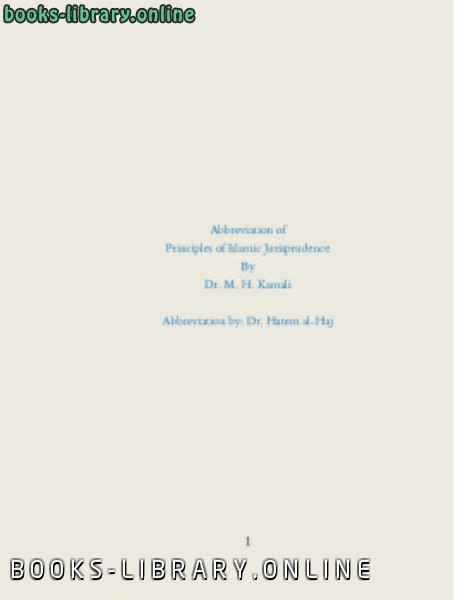📘 قراءة كتاب Principles of Islamic Jurisprudence أونلاين


Preface............................................................................................8
Works of Arabic origin on usul al-fiqh:........................................9
Chapter One: Introduction to Usul al-Fiqh.......................................16
[Definition and Scope Usul al-fiqh]...............................................16
The definition of fiqh is...............................................................18
The founder of usul al-fiqh ..........................................................19
[The Difference Between the Usul, and the Maxims of
Fiqh(alqawa'id al-fiqhiyyah)]............................................................20
Two Approaches to the Study of Usul al-fiqh.................................22
III. Proofs of Shari'ah (Al-Adillah Al-Shar'iyyah) ............................24
Adillah Shar’iyyah ...................................................................24
[Classification of Proofs]...........................................................25
Chapter Two: The First Source of Shari'ah: The Qur'an .....................28
The contents of the Qur’an are not classified subject-wise ............29
The Qur’an consists of manifest revelation..................................29
In the Hadeeth Qudsi ..............................................................29
[Words of non-Arabic origin]...................................................29
[Graduality]............................................................................30
[Transmission] ........................................................................31
[makki & Madani]...................................................................31
Characteristics of Qur’anic Legislation...........................................34
The Definitive (qat’i) and the Speculative (zanni) ........................35
Brevity and Detail (al-ijmal wa'l-tafsil) .......................................38
The Five Values As a characteristic feature of Qur'anic legislation..41
Ratiocination (ta'lil).................................................................42
Inimitability (i'jaz) of the Qur’an ...............................................44
Occasions of Revelation (asbab al-nuzul) ...................................46
Chapter Three: The Sunnah............................................................48
Introduction ..............................................................................48
Usage of the word ‘Sunnah” by various types of ulama.................49
Sunnah and Hadeeth ...............................................................50
khabar and Athar' ....................................................................50
Proof-Value (Hujjiyyah) of Sunnah...............................................52
Classification and Value ...............................................................54
Verbal, Actual Sunnah and Tacit Approval .................................54
Non-legal and Legal Sunnah ....................................................55
Qur'an and Sunnah Distinguished .................................................62
Priority of the Qur'an over the Sunnah..........................................63
Is Sunnah an Independent Source?................................................65
Distortion and Forgery ................................................................69
[History of Forgery] ................................................................69
[Types of Forgery]...................................................................69
Classification and Value:..............................................................71
[From the viewpoint of the continuity of their chains].....................71
The Continuous Hadeeth ........................................................72
The Discontinued Hadeeth (al-Hadeeth Ghayr al-Muttasil) .........76
Sahih, Hasan and Da’if ................................................................77
[Varieties of Da’if]...................................................................78
Chapter Four: Rules of Interpretation I: Deducing the Law from its
Sources ................................................................................................79
Words have beenclassified into various types...............................79
[Benefits of learning the implications of words] ...........................80
Ta'wil (Allegorical Interpretation) .................................................80
[Conditions of Proper Ta’wil]...................................................81
There are two types of ta'wil, namely.........................................82
Classification I: Clear and Unclear Words......................................83
I. 1 & 2 The Zahir and the Nass................................................83
I. 3 & 4 Unequivocal (Mufassar) and Perspicuous (Muhkam) ........86
[Perceived Conflict Between Mufassar and Nass Is not Conflict] ...87
II. Unclear Words (al-Alfaz Ghayr al-Wadihah)..........................88
II. 1 The Obscure (Khafi).........................................................89
II.2 The Difficult (Mushkil)......................................................89
II.3 The Ambivalent (Mujmal)..................................................90
II.4 The Intricate (Mutashabih) .................................................91
Classification II: The 'Amm (General) and the Khass (Specific)..........93
'Amm ....................................................................................93
[Khass]...................................................................................94
[Types of ‘Amm].....................................................................94
[Linguistic forms of ‘Amm].......................................................95
[Is ‘Amm Definitive?] ..............................................................96
[Takhsees by a clause in the same text] .......................................98
[Takhsees by a clause in a separate text]......................................98
Chronological order between the general and the specifying
provisions....................................................................................99
[‘Amm after takhsees not definitive, even by Hanafis] ................ 100
[The cause never specifies a general ruling]............................... 100
Conflict between 'Amm and Khass.......................................... 100
Classification III: The Absolute (Mutlaq) and the Qualified (Muqayyad)
...................................................................................................... 101
[The hanafi Position] ............................................................. 104
Classification IV: The Literal (Haqiqi) and the Metaphorical (Majazi)
...................................................................................................... 104
[linguistic (lughawi), customary (urfi) and juridical (shar'i) usages of
words] ........................................................................................ 105
The Homonym (Mushtarak)................................................... 107
Chapter Five: Rules of Interpretation II: Al-Dalalat (Textual Implications)
......................................................................................................... 109
I. The Explicit Meaning (Ibarah al-Nass) ..................................... 109
II. The Alluded Meaning (Isharah al-Nass)................................... 110
III. The Inferred Meaning (Dalalah al-Nass)................................. 111
IV. The Required Meaning (Iqtida' al-Nass) ................................ 112
[Order of Priority]................................................................. 112
V. Divergent Meaning (Mafhum al-Mukhalafah) and the Shafi'i
Classification of al-Dalalat................................................................. 114
[Shafi'i approach to textual implications (al-dalalat')] .................. 115
[Conditions of deduction by way of mafhum al-mukhalafah]...... 117
[Types of mafhum al-mukhalafah]........................................... 119
Chapter Six: Commands and Prohibitions....................................... 122
I. Commands ........................................................................... 122
[What does a command infer]................................................. 122
[Other implications of a command] ......................................... 123
[The command after a prohibition (al-amr ba'd al-hazar)]........... 124
[ Does a command require a single compliance or repetition?] .... 124
[Does a command require immediate or delayed performance?] .. 125
[Does a command to do something imply the prohibition of its
opposite?].................................................................................... 125
II. Prohibitions......................................................................... 126
III. Value of Legal Injunctions.................................................... 127
[Does a prohibition require both immediate as well as repeated
compliance?]................................................................................ 128
Chapter Seven: Naskh (Abrogation) ............................................... 131
[Juridical Definition].............................................................. 131
There may be instances of conflict between two texts ................ 133
[Establishment of the chronological sequence] .......................... 134
Types of Naskh ........................................................................ 135
In the case of explicit abrogation ............................................. 135
In the case of implicit abrogation............................................. 135
Implicit abrogation has been sub-divided ................................. 136
[Total Abrogation] ................................................................ 136
Partial abrogation (naskh juz'i )................................................ 137
[Abrogation of the Words and Rulings] ................................... 138
[Classification according to the Abrogator] ............................... 138
Naskh and takhsis differ from one another in that ...................... 141
Does a subsequent addition (taz'id) to an existing text, which may be
at variance with it, amount to abrogation? ....................................... 142
The Argument Against Naskh .................................................... 143
This is a great effort that Dr. Hatem made when he abbreviated the book of “Principles of Islamic Fiqh” written by M. H. Kamali. The book was in need to be abbreviated to be within the curriculum of the Dept. of Islamic studies in English.
حجم الكتاب عند التحميل : 851.7 كيلوبايت .
نوع الكتاب : pdf.
عداد القراءة:
اذا اعجبك الكتاب فضلاً اضغط على أعجبني و يمكنك تحميله من هنا:

شكرًا لمساهمتكم
شكراً لمساهمتكم معنا في الإرتقاء بمستوى المكتبة ، يمكنكم االتبليغ عن اخطاء او سوء اختيار للكتب وتصنيفها ومحتواها ، أو كتاب يُمنع نشره ، او محمي بحقوق طبع ونشر ، فضلاً قم بالتبليغ عن الكتاب المُخالف:
 قبل تحميل الكتاب ..
قبل تحميل الكتاب ..
يجب ان يتوفر لديكم برنامج تشغيل وقراءة ملفات pdf
يمكن تحميلة من هنا 'http://get.adobe.com/reader/'


 منصّة المكتبة
منصّة المكتبة